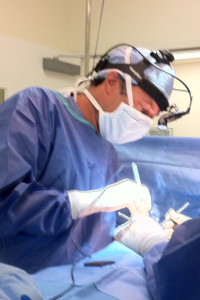Breast Revision Surgery Review
Posted On: September 13, 2012 Author: The Office of Dr. Stuart Linder Posted In: Breast Revision, Breast topics, Ruptured Implant
 Patients who undergo breast revision surgery must realize that by having a secondary, tertiary or having had multiple surgeries in the past, that the original components and anatomy of the breasts have been manipulated and therefore an absolute perfect or normal result may not be possible. Patients must have realistic expectations. When revealing a patient’s breasts after they have had a previous surgery, I look at implant position, sternal distance, scarring, positioning of the implant, upper pole fullness, subpectoral versus retromammary placement of the implant and determine what the true possibilities for correction are. In other words, once a woman’s breasts have been operated on, many variables and factors are permanent and unchangeable. On review, the examination will allow the Board Certified Breast Revision Specialist to determine what is and what is not correctable, including positioning of the implant, repositioning of the implant, visibility of the bag, palpability of the bag, cleavage, inframammary fold, asymmetries, and malpositions. No results can be guaranteed from any specific surgery with respect to final scarring, recurrence of bottoming out or recurrence of capsular contracture. Only Board Certified Plastic and Reconstructive Surgeons should be performing breast revision surgery, as these are very difficult operations. Ruptured implants may be difficult to fix, especially with extravasation of ruptured silicone from the previous old Dow Corning implants which can lead to extracapsular calcification and migration into the axillary lymph nodes. Removal of the entire capsule can leave women with no tissue coverage, leading to severe palpability and visibility of the bag.
Patients who undergo breast revision surgery must realize that by having a secondary, tertiary or having had multiple surgeries in the past, that the original components and anatomy of the breasts have been manipulated and therefore an absolute perfect or normal result may not be possible. Patients must have realistic expectations. When revealing a patient’s breasts after they have had a previous surgery, I look at implant position, sternal distance, scarring, positioning of the implant, upper pole fullness, subpectoral versus retromammary placement of the implant and determine what the true possibilities for correction are. In other words, once a woman’s breasts have been operated on, many variables and factors are permanent and unchangeable. On review, the examination will allow the Board Certified Breast Revision Specialist to determine what is and what is not correctable, including positioning of the implant, repositioning of the implant, visibility of the bag, palpability of the bag, cleavage, inframammary fold, asymmetries, and malpositions. No results can be guaranteed from any specific surgery with respect to final scarring, recurrence of bottoming out or recurrence of capsular contracture. Only Board Certified Plastic and Reconstructive Surgeons should be performing breast revision surgery, as these are very difficult operations. Ruptured implants may be difficult to fix, especially with extravasation of ruptured silicone from the previous old Dow Corning implants which can lead to extracapsular calcification and migration into the axillary lymph nodes. Removal of the entire capsule can leave women with no tissue coverage, leading to severe palpability and visibility of the bag.
Patients who have undergone multiple revision surgeries may no longer be candidates for a breast implant, as the tissue becomes thinned out, there may be substantial coverage to prevent visible rippling palpability and this may require explantation with no longer implant placement. Recurrent long-term effects of breast revision surgery can include skin laxity recurrence, bottoming out, capsular contracture, widespread scarring, keloid hypertrophic scarring, implant malposition, recurrent rupture of silicone or saline implant. In reviewing patients for revision, it is apparent that scarring and scar tissue contracture may occur over time. No plastic surgeon can guarantee a final and permanent outcome.